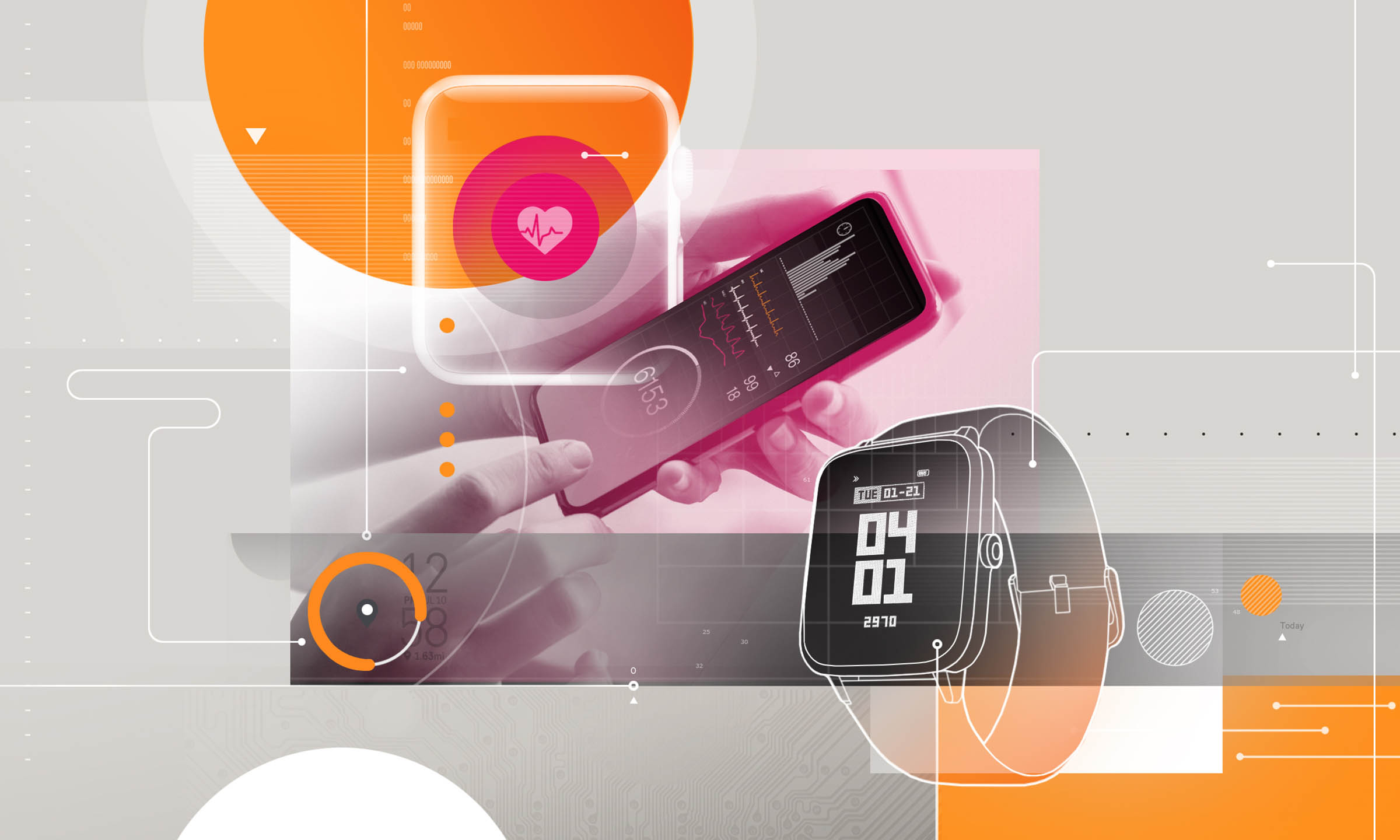Healthcare Apps Promise Powerful Outcomes — If Patients Use Them
Mobile healthcare apps empower patients with access to their own health data. Apps can let patients reach medical providers more easily and can nudge users into better habits. But mobile apps face a distinct challenge: How to keep people using them. In this article, we address how healthcare stakeholders can help patients navigate an increasingly flooded marketplace.

Patrick’s girlfriend, who is a nurse, used to bug him to use his doctor’s portal app instead of calling to make an appointment every time he had a question about his diabetes. When the COVID-19 pandemic hit, he had to stop ignoring her suggestion.
Now, the retired technology guru from California can’t imagine not being able to contact his primary care physician online. He even sends the office medical assistants photos from his fishing trips through the portal.
“I mean, I never used that thing. Right? And now it's like, ‘Hey doc, what's going on? I got some fish for you,’” Patrick joked.
Patrick also uses the app to track his A1C, the standard diabetes test that measures blood sugar levels over time: “Bam, I get to see my labs. You know, 10 years ago … I never knew what my labs were … until the following month when I would go see a doc. Now, I know instantly.”
The most recent data suggests there are now more than 350,000 mobile health apps available in app stores worldwide, and 90,000 — a quarter of the total to date — were added in 2020 alone as locked-down people worldwide sought ways to monitor COVID-19 symptoms, track fitness and stay connected to medical providers.Digital Health Trends 2021, IQVIA Institute for Human Data Science, July 2021
Investment in digital health reached a record $24 billion in 2020 and a new monthly record in December 2020 of $3.4 billion.Digital Health Trends 2021, IQVIA Institute for Human Data Science, July 2021 The global market reached $38 billion in 2021, and year-over-year growth is projected at 12% through 2030.mHealth Apps Market Size, Share & Trends Analysis Report, Grand View Research, 2022
Patients, providers and pharmacists have come to rely on digital connection with one another, with 40% of patients nationwide using a portal in 2020, up 13% since 2014.Individuals’ Access and Use of Patient Portals and Smartphone Health Apps, 2020, Office of the National Coordinator for Health IT, September 2021
The app landscape is dominated by fitness trackers and patient portals, while a growing proportion is centered on helping people manage a specific condition, such as diabetes or heart disease.
Here, we look at the ways digital tools benefit healthcare system stakeholders, the types of tools available and the challenges to convincing patients to adopt regular use of these tools.
What are the benefits of healthcare apps?
Health apps can reduce costs, increase visibility into treatment efficacy and create more engaged, empowered healthcare consumers.
According to the 2022 Medication Access Report, 82% of patients experienced delays in accessing their medications.
In 10% of those cases, they cited communication barriers as the reason. With mobile access to patient records, pharmacists, healthcare providers and payers, those barriers can be broken down.
Digital health tools can help physicians and their practices reduce administrative burdens, expand their practices’ capacity, and offer insight into their patients’ health and wellbeing.
Ada D. Stewart, MD, FAAFP, board chair, American Academy of Family Physicians
Another treatment access challenge mobile apps can help overcome is cost. The 2022 Medication Access Report discovered 79% of patients went to pick up a prescription and found a higher price than they were expecting. Some of today’s most popular healthcare apps address that by comparing drug prices.
Much is at stake when it comes to adherence to treatment regimens. It costs an estimated $5,271 to $52,341 per patient in additional healthcare spend when people fail to take their medications on time or at all.Economic Impact of Medication Non-Adherence by Disease Groups: A Systematic Review, BMJ Open, Jan. 21, 2018
In addition to fewer encounters treating acute illness caused by medication nonadherence, providers benefit from health apps by getting a much fuller view of the patient, deepening the relationship and their ability to spot trends in time to slow or stop disease.
While she cautions patients not to see apps as a replacement for face time with their healthcare providers, “Digital health tools can help physicians and their practices reduce administrative burdens, expand their practices’ capacity, and offer insight into their patients’ health and wellbeing,” said Ada D. Stewart, MD, FAAFP, board chair, American Academy of Family Physicians.
Mobile apps can position pharmacists as more active members of the care team by providing a window into what goes on at the primary provider’s office, hospital and other treatment settings.
Pharma companies get visibility into how their drugs are performing in real-world conditions, while payers ultimately realize the lower costs of care that come with patient adherence to treatment. For the Kaiser Permanente Northern California health system, strategies tied to patients’ electronic health records had increased medication adherence to above 80% as of 2018.The Unmet Challenge of Medication Nonadherence, The Permanente Journal, September 1, 2018
Mobile apps hold powerful potential to inform and engage patients to reach better health outcomes — but only if patients continue using them. Next, we look at digital healthcare products and their strengths and challenges in reaching the ultimate goal: Better population health through regular consumer use and true patient engagement.
What types of mobile health app options are there?
The landscape of digital health products is vast and varied, and as noted, it’s growing. For many, the concept of a mobile health app likely conjures images of fitness and weight trackers, but those are but one common type. Here we look at other common healthcare apps, along with some benefits and challenges for each.
Fitness and weight trackers
These apps have seen widespread adoptionDigital Health Trends 2021, Iqvia Institute for Human Data Science, July 2021 and use. However, their effectiveness can wane as patients become lax in their devotion. Efficacy might depend on whether users enter data themselves or whether devices such as phones capture it.
Patient portals
Patient portals give patients enhanced access to medical records and communication with healthcare providers, pharmacists and payers. A downside is they don’t integrate data across stakeholders.
Prescription discount apps
These apps let patients shop around for the best price on a drug. Unfortunately, the rest of the care team might not know whether a patient filled their prescription, took it as directed and continued to take it. Cash transactions also can rob providers of the insight they need to prevent harmful drug interactions.
Disease-specific apps
Disease-specific apps are a fast-growing segment of patient apps that help users manage chronic conditions. Coaching is key here. Patients who were coached on managing their treatment including taking medications were 25% more adherent to their treatments.Adherence Solutions for Biopharma Companies, McKesson citing Symphony Health Analytics, 2016
Digital therapeutics
This growing class of health apps crosses into bona fide treatment territory, requiring regulatory approval and a prescription to access. There were 250 digital therapeutics, or DTx, as of 2021, with 150 available on the market and the rest in development.Adherence Solutions for Biopharma Companies, McKesson citing Symphony Health Analytics, 2016 Reimbursement for these health enablers is growing. The global digital therapeutics market is expected to reach $28.2 billion in 2030, growing 21% a year.Digital Therapeutics Market Research Report, Strategic Market Research, April 2022
Connected devices
Examples of connected devices include wrist-worn devices, blood pressure cuffs, glucose monitors and CPAP machines that report and store results in the cloud. The power here is that users don’t have to manually enter data. But they do have to consistently use the devices.
Why do people keep — or drop — mobile health apps?
The app landscape is a riot of logos and choices, as evidenced by the home screens of many cellphones. How do developers keep people engaged, and what are some reasons patients fail to keep using healthcare apps?
Some products can be too specific, leaving the user unmotivated to open it and use it just for one purpose each day, such as a medication reminder. Others do not offer a strong user experience, including too much information or not enough. And in the healthcare space, with privacy a concern, some apps and brands may fall short on the trust factor patients need for regular use.Pharma and the Connected Patient, Deloitte, 2017
In a 2020 study by the U.S. Office of the National Coordinator for Health IT, 69% of patients said they avoided using the patient portal at least once during the past year because they wanted to speak with their healthcare provider directly. About a quarter said they had privacy concerns about their health data.Individuals’ Access and Use of Patient Portals and Smartphone Health Apps, 2020, Office of the National Coordinator for Health IT, September 2021
Other times, the apps are superseded by a superior rival, or developers fail to maintain them, and their functionality suffers. While 351,000 new apps debuted in the Apple Store and Google Play from July 2017 to June 2021, the net gain was only 32,736 apps because of older and nonfunctioning apps being removed.Digital Health Trends 2021, Iqvia Institute for Human Data Science, July 2021
What’s the future of mobile health apps?
With technology, our shared desire for better human health is more achievable than it ever has been. Central to that future is true patient engagement with their healthcare journey.
Apps are poised to make the leap from single-purpose, utilitarian bots to become true digital health companions, giving patients individual attention, personalization and ultimately power.
Historically, patients have waited for a medical professional to offer informed opinions, share instructions and prescribe drugs. Results were measured perhaps a few times a year with in-person check-ins.
Mobile health apps invite patients to provide much more frequent input as to symptoms, biometric data and mood — such as Patrick, who sends the health data from his watch to his doctor.
Using gamification, developers can make the process fun and create ways to celebrate successes along the path to better health. And the potential for technology to level the playing field across haves and have-nots is powerful.
“Given that the U.S. faces a digital divide, these products should be accessible and equitable for all,” Stewart said.
True patient engagement with a healthcare ecosystem rendered eminently more accessible and more collaborative by technology? That sounds like a future we all can get behind.
For more on how patients and healthcare providers are using technology, read the 2022 Medication Access Report.
The latest healthcare insights, floated right to your inbox.





